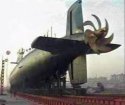A) Who knows?
B) Judging by some available circumstantial evidence, I'd say they're where US subs were anywhere from late 1980s to late 1990s.
Reasoning for that assessment:
Subs' noise is derived from the following (not an exhaustive list):
1. Size. The bigger the hull is, the more room there is for noise insulation. - 093 seems quite close in hull diameter to LA class, when both are measured via GE earth. Certainly, 093 is visibly wider than French Rubis class from the 1980s, for example.
2. Number and design of shafts and propellers. Single shaft and single propeller makes least noise. And skewback design of prop again makes that noise even lower. LA class (and earlies classes even) had that. Russian subs, for example started featuring those only in1980s. We have seen official models of chinese made export conventional subs with skewback props, so it's likely 093 uses the design too. After all, since the cold war ended, the design was no longer held a secret, so the general shape is now known.
3. Precisely and finely made machinery. The more finely made it is, the nicer all the clogs and parts work together, making less noise. Computer controlled designed and milling machines helped there immensely, and that is one area China is quite good at. I find it unlikely that 093 would have worse tolerances than a LA class design made in 1980s.
4. Natural circulation for part of the reactor work envelope. Some older subs, including LA class, used pumps throughout all their working envelope too cool their reactors. There have been news of teams in China getting award for natural circulation around reactors for new submarines, and that was years ago. If true, this would be another area where latest 093 are ahead of improved LA class.
So, all in all, I find it unlikely that newest 093 (ones commissioned in the last 5 or so years) are not at least as quiet as improved LA class. And it's quite plausible they're somewhat quieter, given the various advances mentioned here. Simply said, the earlier 093 subs and these newest one should be two different classes, really.




